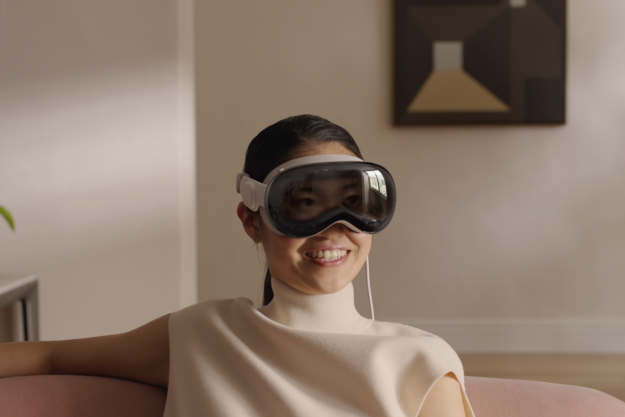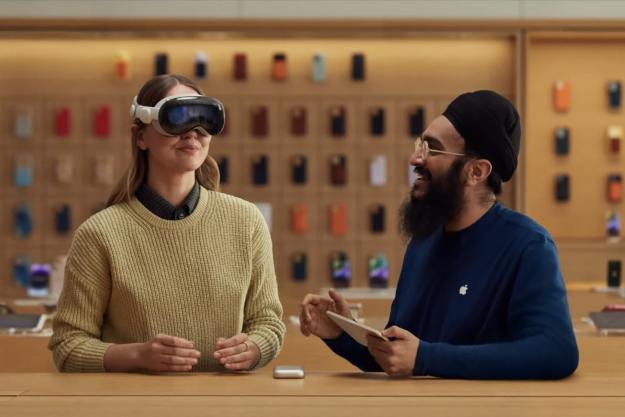However, as more and more creative minds get their hands on the necessary tech, we’re going to see it used for a much broader set of projects. One such piece of work was submitted to the Oculus Mobile VR Jam 2015, and rather than seeking to entertain, it outlines a unique form of therapy for those who’ve recently lost a loved one.
Handling real grief, virtually
Crossover was created by Kent Bye, Heather Beckett, Eran Haas and Matt Henderson, and places its audience-of-one in a house comprising of three rooms; a den, a bedroom and a nursery. These three rooms play host to lost souls, and you can travel between them as you wish, listening in on their conversations.
Crossover comes from a place of real emotion, drawing on real experiences from the lives of its creators.
Different types of loss are addressed in each location. The nursery focuses on the loss of a child, while the den discusses the loss of a parent and the bedroom covers the loss of a significant other. The user experiencing the narrative can move freely between the rooms to observe the characters as they see fit.
The team behind Crossover describe it as “Sleep No More meets Sixth Sense in VR,” and it’s not too difficult to see where those comparisons come from. It may look like a video game, but it’s not — this is closer to a piece of experimental, experiential theater.
Death is a difficult subject to broach in any art form, but the fact that virtual reality is such a new form makes it a particularly tricky medium. However, Crossover comes from a place of real emotion, drawing on real experiences from the lives of its creators.
Kent Bye’s experience as a mobile and VR developer helped make the technical side of Crossover become a reality, but his life experience played a huge role in informing its content. The loss of his father-in-law, the loss of a child during pregnancy and the loss of his wife to suicide shortly before the project all contributed to what he refers to as “radical authenticity.”
Avoiding “Uncanny Valley”
“Anytime you try to describe an experience to someone, you inevitably get to the point of saying, “Well, you just had to be there to really understand.” Kent tells me when I ask how the use of VR made Crossover possible. “I believe virtual reality is a new communications medium where you can start to share experiences that can’t be captured by describing them or seeing them in a video.”

Crossover occupies a curious corner of the often-referenced Uncanny Valley. The subject matter here is very real and very raw — but its presentation is not. We often think of virtual reality in terms of immersion, but the flat shaded walls and obviously polygonal faces that make up the visuals of this project don’t allow the viewer to lose themselves in the experience in the traditional sense.
“This was a deliberate design decision in order to create the most immersive experience that we possibly could,” Kent says. “As you move toward photorealistic avatars in VR, then that starts to set your expectations that their behavior is going to also be completely realistic. If it’s not, then it’ll feel like a break in presence, and the house of cards of a coherent experience will come crumbling down.”
“If it’s authentic and true enough then it’s possible that it might provide some healing for other people as well.”
Instead of aiming for graphical fidelity, Crossover attempts to make its characters feel human in other ways. Kent praises the work of the voice actors for their performances, which are supplemented by Faceshift technology that allows their in-game avatars to emote. The overall effect might not be photorealistic, but it’s believable in a different way.
“It was a really surreal experience to see this script come to life to the point of feeling like I was in the same room overhearing an intimate conversation,” Kent says, when I ask him about the process of bringing the game to life. “Conversations that either actually happened in my life, or were imagined conversations that I wish that I could have. It’s a feeling that I can’t even completely describe beyond that it was a visceral experience where my subconscious mind was often tricked into believing that these scenes were actually playing out.”
“The final scene had all five actors and so we had to run through it five times. By the end of recording the final take of the final scene, everyone in the room was in tears because the emotional charge just kept building and building.”
Personal space, opened to the public
Crossover ends with its cast of characters brought together for a seven-minute “grief ritual.” In a sense, that release is virtual — but for Kent it’s very real, and he hopes that anyone experiencing the project can use it to help work through their own grief.
“My intention was to create a piece of art that was primarily meant for me in order to help me explore and heal from my experiences,” Kent says. “If it’s authentic and true enough then it’s possible that it might provide some healing for other people as well.”
By that measure, Crossover is already a success. Kent posted information about the project on Reddit in May, and was met with fiercely positive response. Users flocked to offer their condolences, as well as share their own experiences and discuss how Crossover impacted them.
Kent described sharing the project so publicly as a very sensitive and vulnerable experience, particularly since it represented him mixing his work life with his personal life. Thankfully, the results seem to have been resoundingly positive.
“The weird thing about mixing the personal and professional is that this piece of sacred healing art is being entered within the context of a global competition,” Kent tells me. “Those two things don’t necessarily go together in my mind, and so it’s a cognitive dissonance. It’s also something that I have to maintain the deeper intention of the project, which was primarily for my own healing. I want it to reach many people who might find it useful.”
Crossover is freely available to download as part of its entry into the Oculus Mobile VR Jam. Kent hopes that taking it to as broad an audience as possible will allow it to play some part in the healing process for anyone that might need it, and demonstrate just what virtual reality can do in this context.
“I’m more and more convinced that VR is a brand new communications medium that will be able to convey human experiences directly to our subconscious minds,” he says. “It’s still the Wild West of what this will mean, but I feel like the multi-threaded approach to storytelling is a really elegant way to be able to mix agency with narrative in VR.”
However, these lofty aims are a potent by-product of the main aim of Crossover — to help a man work through his grief. Virtual reality gives us the opportunity to create our own spaces and situations to inhabit and experience, and that could be a very powerful tool if it’s used with the same sense of care and consideration found in Crossover.
Editors' Recommendations
- This new VR headset beats the Vision Pro in one key way and is half the price
- Get the most out of Meta Quest 3’s mixed-reality with these VR games
- Apple’s Vision Pro may help your eyesight in this genius way
- The next Vision Pro could let you see invisible energy
- Apple’s Vision Pro could get this incredible gaming upgrade


